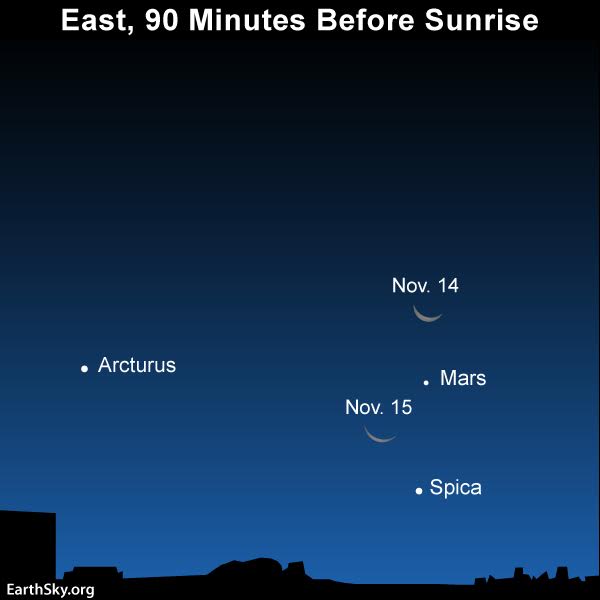
Jupiter and Venus have their spectacular conjunction Monday morning – November 13, 2017 – but keep watching for these planets after that as well! The waning crescent moon has joined the show, sliding first past Mars on November 14 and 15, and then continuing to move downward – closer to the sunrise each morning – to pass Venus and Jupiter before this week ends.
First … the moon and Mars on Tuesday and Wednesday mornings. The planet Mars is much fainter than Jupiter or Venus, but the moon can help you find it. Also, notice the bright star Arcturus on our chart. From the Southern Hemisphere, Arcturus will be difficult or impossible to see. But Northern Hemisphere observers will see it. Its color is orangish … not very different from Mars, but more twinkly.
If you want to see Mars, remember, it’s faint and far across the solar system now. Be sure to look for it before dawn, or about one and one-half to two hours before sunrise. This rather faint world will quickly fade from view once the predawn darkness gives way to morning twilight. And speaking of morning twilight …

Next … look for dazzling planets Jupiter and Venus. Their conjunction was Monday, November 13, when they were less than a moon-width apart. But they’ll remain close as the moon moves past them this week.
Click here to see fav photos from around the globe of Monday morning’s spectacular Venus-Jupiter conjunction. Thanks to all who submitted or posted at EarthSky Facebook. Keep watching this link … we’ll add more pics as the moon moves past the planets this week.
Venus and Jupiter won’t climb up over your eastern horizon until shortly before before sunrise, there will be a very narrow window of time – or maybe no time at all – during which you can see Venus, Jupiter and Mars all at the same time. In other words … the light of the coming dawn will cause Mars to fade from view.
From the Southern Hemisphere, Jupiter and Venus rise even closer to the time of sunrise than they do at northerly latitudes.
Click here for recommended sky almanacs; they can tell you the rising times for the planets and bright stars into your sky.
Take a good look at Mars before dawn these next few mornings, as it casts its meek light in the predawn sky. Earth in its smaller, faster orbit around the sun is slowly but surely catching up with Mars, the fourth planet outward from the sun. Earth will pass between the sun and Mars – and so reach what astronomers call opposition – on July 27, 2018. Then, Earth will be about six times closer to Mars than it is now. Mars, in turn, will shine nearly 40 times more brilliantly in our sky than it does now.
In fact, 2018 will be a spectacular year for Mars! The planet has a 15 to 17-year cycle whereby Mars shines exceptionally brilliantly at opposition. The peak of that cycle will come again in 2018.
By mid-February 2018, Mars will have doubled in brilliance, shining on par with the 1st-magnitude stars Spica and Antares. Moreover, Mars will be coupling up with the star Antares on the sky’s dome in mid-February 2018, giving sky watchers an opportunity to view the red planet Mars and red star Antares shining next to each other on the great dome of sky.
Their similarity in brightness and color will let you learn firsthand why this star was given the name Antares, which means like Mars.
Bottom line: Use the moon to find the planet Mars on the mornings of November 14 and 15, and then watch for Mars to brighten in the morning sky for many months to come.











